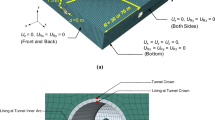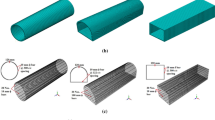Abstract
The present work deals with the three-dimensional nonlinear finite element (FE) analyses of the tunnel in soil subjected to internal blast loading. The analyses are performed using the coupled Eulerian–Lagrangian analysis tool in FE software Abaqus/Explicit. The soil and reinforced concrete lining are modeled using the Lagrangian elements. The explosive Trinitrotoluene (TNT) is modeled using the Eulerian elements. The stress–strain response of soil, concrete, and reinforcement are simulated using strain rate dependent Drucker–Prager plasticity, concrete damaged plasticity and Johnson–Cook (J–C) plasticity models, respectively. The pressure–volume relationship of the TNT explosive is simulated using the Jones-Wilkins-Lee equation of state. Parametric sensitivity studies have been performed for different (1) tunnel lining thicknesses, (2) explosive charge weights and (3) angles of internal friction of soil. It is observed from the results that blast induced pressure on the tunnel lining increases with the increase in charge weight. Both the lining and the surrounding soil undergo significant deformation. The deformation of the tunnel lining increases with increasing charge weight and decreases with increasing lining thickness and increasing the angle of internal friction of soil. Blast-induced velocity in soil attenuates with increasing distance from the source of the blast.


(Veyera and Ross 1995)



















Similar content being viewed by others
References
Abaqus/Explicit User’s Manual, version 6.11 (2011) Dassault systèmes simulia corporation, Providence, Rhode Island, USA
Al-Rub RKA, Kim SM (2010) Computational applications of a coupled plasticity-damage constitutive model for simulating plain concrete fracture. Eng Fract Mech 77:1577–1603
Bischoff PH, Perry SH (1991) Compressive behavior of concrete at high strain rates. Mater Struct 24:425–450
Carreira DJ, Chu K (1985) Stress strain relationship for plain concrete in compression. ACI J 82(6):797–804
Carreira DJ, Chu K (1986) Stress strain relationship for reinforced concrete in tension. ACI J 83(1):21–28
Chakraborty T, Larcher M, Gebbeken N (2013) Comparative performance of tunnel lining materials under blast loading. In: Proceedings of 3rd International Conference on Computational Methods in Tunneling and Subsurface Engineering, Ruhr University Bochum, Germany, 17th–19th April 2013
Chille F, Sala A, Casadei F (1998) Containment of blast phenomena in underground electrical power plants. Adv Eng Softw 29(1):7–12
Choi S, Wang J, Munfakh G, Dwyre E (2006) 3-D nonlinear blast model analysis for underground structures. In: Proceedings of ASCE Geo-Congress 2006, Atlanta, Georgia, USA, 26th Feb–1st March 2006, pp 1–6
Design specifications Delhi Metro Rail Corporation Limited, Barakhamba road, New Delhi, India
Du H, Li Z (2009) Numerical analysis of dynamic behavior of RC slabs under blast loading. Transactions of Tianjin University 15(1):61–64
Dusenberry DO (2010) Handbook for blast resistant design of buildings, 1st edn. Wiley, Hoboken
Feldgun VR, Kochetkov AV, Karinski YS, Yankelevsky DZ (2008a) Internal blast loading in a buried lined tunnel. Int J Impact Eng 35(3):172–183
Feldgun VR, Kochetkov AV, Karinski YS, Yankelevsky DZ (2008b) Blast response of a lined cavity in a porous saturated soil. Int J Impact Eng 35(9):953–966
Goel MD, Matsagar VA, Gupta AK, Marburg S (2012) An abridged review of blast wave parameters. Def Sci J 62(5):300–306
Gui MW, Chien MC (2006) Blast resistant analysis for a tunnel passing beneath Taipei Shongsan airport—a parametric study. Geotech Geol Eng 24:227–248
Higgins W, Chakraborty T, Basu D (2012) A high strain-rate constitutive model for sand and its application in finite element analysis of tunnels subjected to blast. Int J Numer Anal Meth Geomech 37(15):2590–2610
Johnson GR, Cook WH (1983) A constitutive model and data for metals subjected to large strains, high strain rates and high temperatures. In: Proceedings of 7th International Symposium on Ballistics, Hague, Netherlands, 19th–21st April 1983, pp 541–547
Karinski YS, Feldgun VR, Yankelevsky DZ (2008) Explosion-induced dynamic soil-structure interaction analysis with the coupled Godunov-variational difference approach. Int J Numer Meth Eng 77(6):824–851
Larcher M, Casadei F (2010) Explosions in complex geometries—comparison of several approaches. European Commission, Joint Research Centre, Institute for Protection and Security of the Citizen, Italy
Lee J, Fenves GL (1998) Plastic damage model for cyclic loading of concrete structures. J Eng Mech 124(8):892–900
Lee JH, Salgado R (1999) Determination of pile base resistance in sands. J Geotech Geoenviron Eng ASCE 125(8):673–683
Liu H (2009) Dynamic analysis of subway structures under blast loading. Geotech Geol Eng 27(6):699–711
Liu H (2011) Damage of cast-iron subway tunnels under internal explosions. In: proceedings of ASCE Geo-Frontiers 2011, Dallas, Texas, USA, 13–16 March 2011, pp 1524–1533
Liu H (2012) Soil-structure interaction and failure of cast-iron subway tunnels subjected to medium internal blast loading. J Perform Constr Fac ASCE 26(5):691–701
Lu Y (2005) Underground blast induced ground shock and it’s modeling using artificial neural network. Comput Geotech 32:164–178
Lubliner J, Oliver J, Oller S, Onate E (1989) A plastic damage model for concrete. Int J Solids Struct 25(3):299–329
Mosallam A, Elsanadedy MH, Almusallam HT, Al-Salloum AY (2015) Structural evaluation of reinforced concrete beams strengthened with innovative bolted/bonded advanced FRP composites sandwich panels. Compos Struct 124:421–440
Nateghi R (2012) Evaluation of blast induced ground vibration for minimizing negative effects on surrounding structures. Soil Dyn Earthq Eng 43:133–138
Ngo T, Mendis P, Gupta A, Ramsay J (2007) Blast loading and blast effects on structures—an overview. Electron J Struct Eng Spec Issue Load Struct 7:76–91
Qiu G, Henke S, Grabe J (2011) Application of a coupled Eulerian–Lagrangian approach on geomechanical problems involving large deformations. Comput Geotech 38(1):30–39
Sainoki A, Mitri HS (2014) Numerical simulation of rock mass vibrations induced by nearby production blast. Can Geotech J 51(11):1253–1262
Tan LY (2010) Characterizing a reinforced concrete connection for progressive collapse assessment. Master’s Thesis, University of Florida, USA
Tiwari R, Chakraborty T, Matsagar V (2014) Dynamic analysis of underground tunnels subjected to internal blast loading. In: The proceedings of 11th World Congress on Computational Mechanics (WCCM-ECCM-ECFD 2014), Barcelona, Spain, 20th–25th July, 2014, pp 6667–6678
TM5-1300 (1990) Structures to resist the effects of accidental explosions. Technical Manual of the US Departments of the Army and Navy and the Air Force, USA
UFC 3-340-02 (2008) Structures to resist the effects of accidental explosions. Unified Facilities Criteria, US Departments of Army and Navy and Air Force, USA
Veyera GE, Ross CA (1995) High strain rate testing of unsaturated sands using a split-Hopkinson pressure bar. In: Proceedings of 3rd International Conference on Recent Advances in Geotechnical Earthquake Engineering and Soil Dynamics, St.-Louis, Missouri, USA, pp 31–34
Yang Y, Xie X, Wang R (2010) Numerical simulation of dynamic response of operating metro tunnel induced by ground explosion. J Rock Mech Geotech Eng 2(4):373–384
Zhao CF, Chen JY (2013) Damage mechanics and mode of square reinforced concrete slab subjected to blast loading. Theor Appl Fract Mech 63–64:54–62
Author information
Authors and Affiliations
Corresponding author
Additional information
The present work is an extension of the conference manuscript Tiwari et al. (2014).
Rights and permissions
About this article
Cite this article
Tiwari, R., Chakraborty, T. & Matsagar, V. Dynamic Analysis of Tunnel in Soil Subjected to Internal Blast Loading. Geotech Geol Eng 35, 1491–1512 (2017). https://doi.org/10.1007/s10706-017-0189-9
Received:
Accepted:
Published:
Issue Date:
DOI: https://doi.org/10.1007/s10706-017-0189-9





